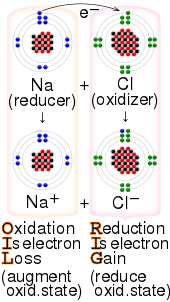Electron transfer

Electron transfer (ET) occurs when an electron relocates from an atom or molecule to another such chemical entity. ET is a mechanistic description of certain kinds of redox reactions involving transfer of electrons.[2]
Classes of electron transfer
Inner-sphere electron transfer
In inner-sphere ET, the two redox centers are covalently linked during the ET. This bridge can be permanent, in which case the electron transfer event is termed intramolecular electron transfer. More commonly, however, the covalent linkage is transitory, forming just prior to the ET and then disconnecting following the ET event. In such cases, the electron transfer is termed intermolecular electron transfer. A famous example of an inner sphere ET process that proceeds via a transitory bridged intermediate is the reduction of [CoCl(NH3)5]2+ by [Cr(H2O)6]2+. In this case, the chloride ligand is the bridging ligand that covalently connects the redox partners.
Outer-sphere electron transfer
In outer-sphere ET reactions, the participating redox centers are not linked via any bridge during the ET event. Instead, the electron "hops" through space from the reducing center to the acceptor. Outer sphere electron transfer can occur between different chemical species or between identical chemical species that differ only in their oxidation state. The latter process is termed self-exchange. As an example, self-exchange describes the
- [MnO4]− + [Mn*O4]2− → [MnO4]2− + [Mn*O4]−
In general, if electron transfer is faster than ligand substitution, the reaction will follow the outer-sphere electron transfer.
Often occurs when one/both reactants are inert or if there is no suitable bridging ligand.
A key concept of Marcus theory is that the rates of such self-exchange reactions are mathematically related to the rates of "cross reactions". Cross reactions entail partners that differ by more than their oxidation states. One example (of many thousands) is the reduction of permanganate by iodide to form iodine and, again, manganate.
Five steps of an outer sphere reaction
- Reactants diffuse together, forming an "encounter complex", out of their solvent shells => precursor complex (requires work =wr)
- Changing bond lengths, reorganize solvent => activated complex
- Electron transfer
- Relaxation of bond lengths, solvent molecules => successor complex
- Diffusion of products (requires work=wp)
Heterogeneous electron transfer
In heterogeneous electron transfer, an electron moves between a chemical species and a solid-state electrode. Theories addressing heterogeneous electron transfer have applications in electrochemistry and the design of solar cells.
Vectoral electron transfer
Especially in proteins, electron transfer often involves hopping of an electron from one redox-active center to another. The hopping pathway, which is viewed as a
Theory
The first generally accepted theory of ET was developed by
See also
- Electron equivalent
- Electrochemical reaction mechanism
- Solvated electron
References
- ^ "Metals". Bitesize. BBC. Archived from the original on 2022-11-03.
- S2CID 208754569.
- ISBN 0-7506-3365-4.
- ISBN 0-12-352651-5.
- ; Publication Date: May 1978
